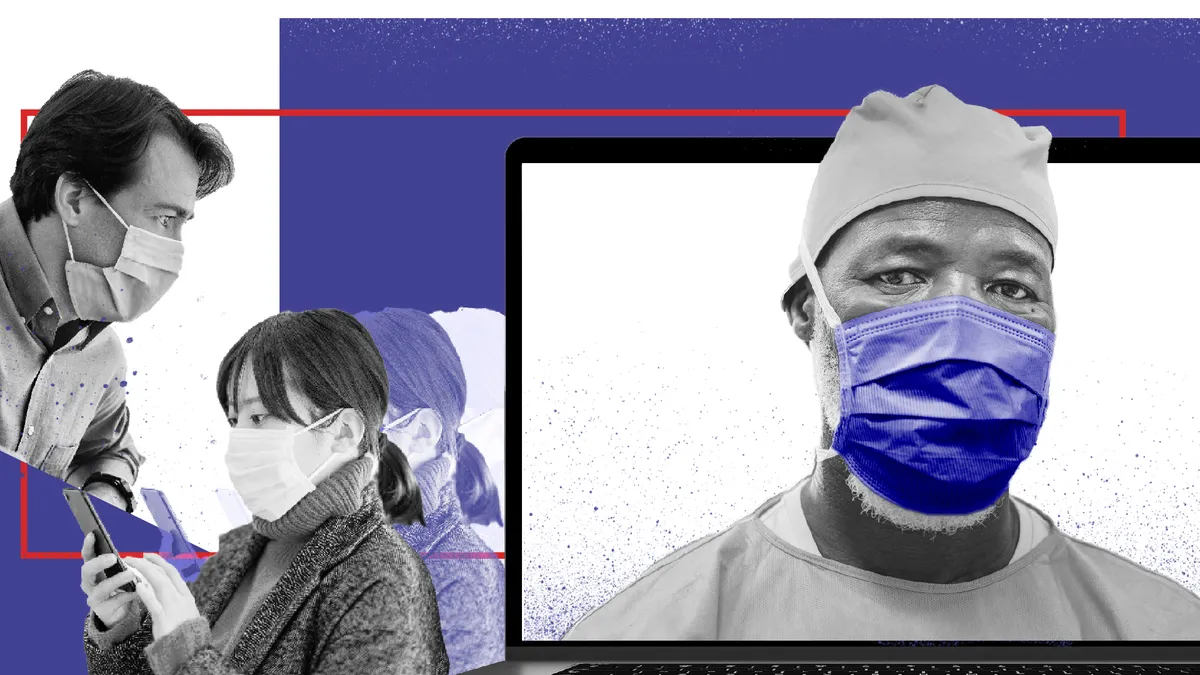Telehealth, which encompasses sub-categories like telemedicine, has become a go-to for healthcare providers and patients as they navigate the logistical and practical challenges posed by the COVID-19 pandemic.
Some of the utilization figures are staggering. Philadelphia's Jefferson Health hospital network went from conducting dozens of telemedicine sessions per week to scheduling 500 to 600 such visits per day in March, according to a report by the American Association of Medical Colleges, reflecting an effort by the network to move outpatient visits to virtual ones.
Insurers, too, are noticing similar jumps. A spokesperson for Cigna told HR Dive in an emailed statement that the company has seen a three-fold increase in virtual care utilization compared to the same period in April 2019. Aetna, which told HR Dive in an emailed statement that it waived cost sharing for plan members' covered telemedicine visits in March, said it has seen "a significant increase in use."
That's a stark difference from low virtual care utilization rates of the past: an October 2019 report from HR consulting firm Mercer found that among employers offering telemedicine, only 9% of eligible employees on average used the benefits.
Initially, telemedicine providers weren't ready for the jump in demand at the onset of the pandemic, Kate Brown, leader of Mercer's Center for Health Innovation, told HR Dive in an interview. "They didn't have all the doctors on staff to meet the quick turnaround times."
Increased volume led to wait times that spiked during what Brown called a "reactionary period" — in which vendors worked to accommodate the increased demand — to sometimes an hour or more. But even that kind of wait can compare favorably to an in-patient visit. "An hour can be a long time, much longer than you're used to from a telemedicine perspective, but maybe still shorter than seeing your doctor in person," Brown said.
As unfortunate as the circumstances may be for all parts of the healthcare system, Brown and others believe that the pandemic presents a strong opportunity for the growth of telehealth solutions, and they expect consumers to continue to use telehealth after COVID-19 subsides.
"I suspect that utilization will continue once all the immediate drama dies down," Kim Buckey, vice president of client services at benefits engagement and compliance vendor DirectPath, told HR Dive in an interview. "Now that people have experience with [telehealth], those employers that haven't already offered it are going to be on board with it."
Recent actions at the federal level could accelerate the trend, she noted. The Coronavirus Aid, Relief and Economic Security Act, passed by Congress March 27, allows a high-deductible health plan with a health savings account to cover a patient's telehealth services prior to the patient reaching their deductible, according to the nonprofit American Telemedicine Association.
"Every employer is going to have to take a step back and ask themselves, 'how could we have been better prepared with this pandemic?'"

Kate Brown
Leader, Center for Health Innovation at Mercer
Similarly, the U.S. Department of Health and Human Services (HHS) announced last month it would "exercise its enforcement discretion" and would not impose penalties for noncompliance with the federal law restricting healthcare providers' release of medical information in connection with the "good faith provision" of telehealth during the pandemic. "This exercise of discretion applies to telehealth provided for any reason, regardless of whether the telehealth service is related to the diagnosis and treatment of health conditions related to COVID-19," HHS said.
Sources also said they expect the experience to compare favorably with patients' experiences outside of the healthcare context. "Patients have seen how easy and convenient telehealth can be," Karen Frost, vice president, health and strategy solutions at benefits outsourcing firm Alight Solutions, said in an email. "The telehealth experience is similar to the consumer experiences they enjoy in their personal lives."
Hurdles to adoption may persist
But even a period of peak demand and a favorable landscape could present hurdles. Increased capacity continues to be an issue, Buckey noted, because providers may not have enough clinical staff despite preparing their systems to handle the influx of patients.
More prominent are concerns about how providers bill for virtual care. Stories of expensive, surprise healthcare bills have already come to light during the pandemic, Kaiser Health News reported, including those for a follow-up phone call and an "administrative fee" for a video visit.
Buckey said that, particularly within the context of COVID-19 testing and treatment, "it's going to take time for billers and coders to get up to speed." She noted that it may be good for employees seeking such care to carefully record the circumstances of their care: "It would behoove people in general to take really good notes about who said what. In terms of testing, what you did get, where you had the test done, how long did you stay, what level of care did you receive."
A separate Kaiser Health News report detailed concerns from federal authorities about the potential for telehealth fraud during the pandemic, particularly in the context of Medicare. Specifically, officials worry that telehealth companies may take advantage of Medicare patients by marketing products like "bogus genetic testing" and unwanted medical equipment, Kaiser Health News said.
Brown said she didn't agree that telehealth is particularly susceptible to healthcare fraud. "It's certainly not unique to telemedicine," she added. "I'm not sure what specifically it is that telemedicine can take advantage of ... it seems hypothetical to me."
Still, not all healthcare needs can be fulfilled via telehealth, including certain testing and physical examinations that require in-person visits. But the technology is helpful for triage, Buckey said, and can help those with symptoms determine whether they need to follow up in person.
General outlook
Overall, employee impressions of telehealth during the pandemic have been very positive, Frost said. "It provides the convenient access they need to a physician, either their own or through a telehealth provider. It's particularly helpful to individuals who live far away from medical facilities or who cannot transport themselves to a facility."
The success of telehealth could lead to a massive change in the employee benefits landscape. A Forrester report shared with HR Dive predicted that the total number of U.S. telehealth visits would surpass 1 billion by the end of 2020, including 900 million such visits related to COVID-19. "The question is no longer about demand but rather providers' ability to give adequate support for consumers seeking this model," Forrester said. "We expect time and resource constraints to create a supply crisis for virtual care during the pandemic."
Insurers appear to have high expectations for telehealth's growth as well. "We believe telemedicine will continue to be a critical tool as we face the pandemic and, as a result, a more accepted option for care in the future," Aetna said. "We think this will be true for all health needs, including mental health and wellbeing services."
Employers will need to ensure that they're not only aware that employees are using telehealth in the current environment, but also actively encouraging employees to use such services, Brown said. The pandemic, she added, could be a test case in preparing for business disruption ahead of time.
"Every employer is going to have to take a step back and ask themselves, 'how could we have been better prepared with this pandemic?'" Brown said. "Their HR strategy needs to account for that."


















